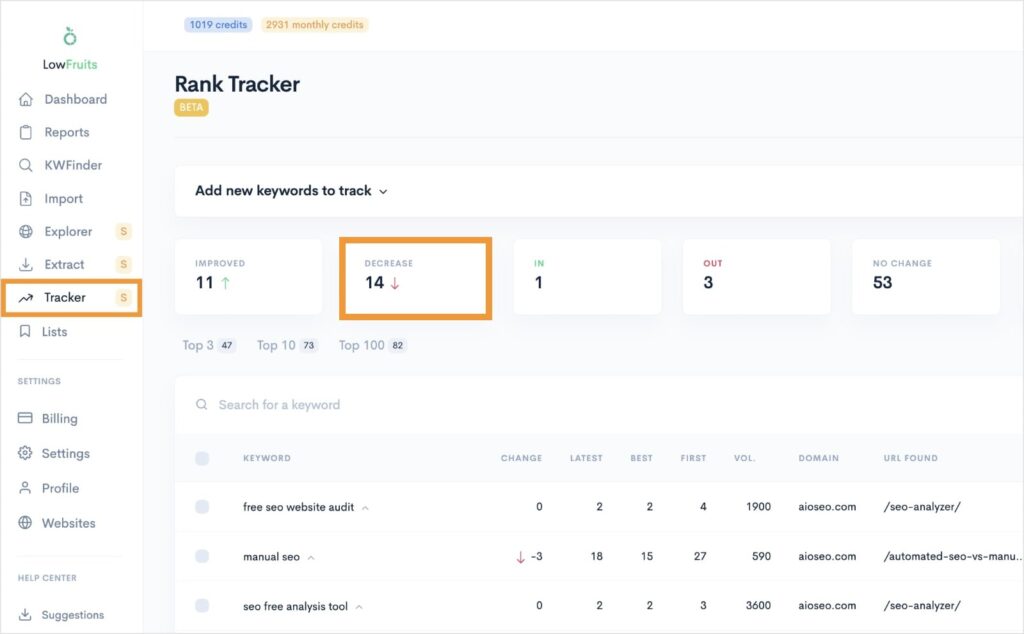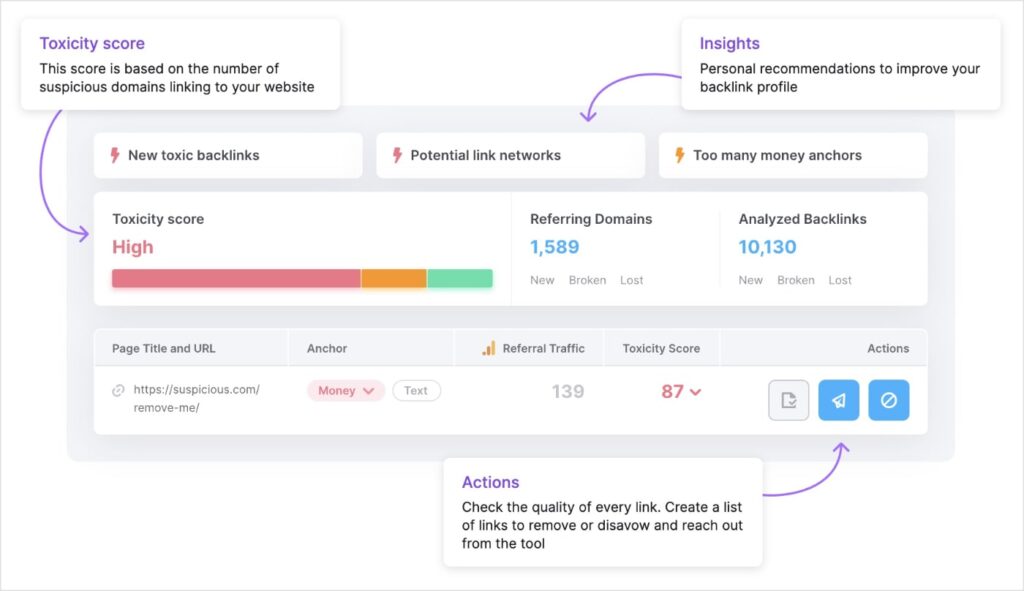Negative SEO: What It Is & How to Protect Your Website
Gabriela Jhean
Have you ever worked tirelessly on your website’s search engine ranking, only to see it take a sudden plunge? It might be the result of a negative SEO attack.
Table of Contents
What Is Negative SEO?
Negative SEO refers to unethical practices used to harm a competitor’s website ranking in search results. The goal is to manipulate search engines into thinking the target website is low-quality or uses spammy tactics. This can lead to penalties and a drop in rankings.
7 Types of Negative SEO
1. Content Scraping
Content scraping is the practice of stealing a website’s content and publishing it elsewhere. It creates duplicate content issues, which can lead to a loss in rankings and visibility for your site. Search engines may struggle to determine the original source and can potentially choose the copied content over yours.
2. Link Spamming
Link spamming occurs when a competitor targets your site with an influx of low-quality backlinks. These links are often irrelevant to your niche or come from spammy websites. They can make your website appear suspicious to search engines and suggest manipulative ranking tactics, potentially triggering penalties for your site.
For example, imagine you have a food blog on the rise. A competitor could pay for a service to create thousands of backlinks to your website from unrelated domains like gambling or scam sites. This could dilute your topical authority and raise red flags with search engines.
3. Link Removal
Contrary to link spamming, attackers may try to remove valuable backlinks to your website. High-quality backlinks from reputable websites act as a positive signal for search engines. When competitors contact website owners and convince them to remove links to your site, it weakens your backlink profile. This can reduce your website’s authority in the eyes of search engines and negatively impact your ranking power.
4. Hacking
Gaining unauthorized access to your website can be used to inject malicious code or redirect traffic away from your site. Hackers can exploit vulnerabilities in your website’s security that can harm its functionality. In extreme cases, hackers might even redirect your website traffic to another website, stealing your potential customers and damaging your site’s health.
For example, a competitor might hack into your website and inject malware that redirects visitors to a phishing site designed to steal their personal information. This could permanently damage your reputation, lead to a loss of customers, and potentially trigger legal action.
5. Smear Campaigns
Smear campaigns aim to spread false information or negative reviews about your business online. This tactic can damage your reputation and significantly impact user trust. Attackers might create fake accounts or exploit existing ones to spread misinformation about your business, products, or services. This can scare away potential customers who rely on online research before making a purchase.
6. Review Bombing
Similar to smear campaigns, review bombing occurs when your business is flooded with negative reviews. Online review platforms greatly influence potential customers’ purchasing decisions. When attackers bombard your business with negative reviews, regardless of their actual experience, it can harm your reputation and be detrimental to your revenue. Review bombing is particularly damaging for local businesses that rely on online reviews.
7. Hotlinking and Heavy Crawling
Hotlinking occurs when someone embeds images or other media on their website, but those files are actually hosted on your server. Every time a user visits their site, your server is hit with a request to load that content. This unauthorized bandwidth usage can lead to the following:
- Slow loading times
- Poor user experience
- Lower search rankings
As for heavy crawling, this practice uses bots to bombard your website with rapid-fire requests. It can overwhelm your server, leading to slowdowns or complete site crashes. It can also negatively affect your SEO if site crashes are frequent enough to damage your credibility with search engines.
How to Spot a Negative SEO Attack
Now that you know the most common types of negative SEO attacks, let’s learn how to spot one.
- Sudden Drop in Rankings: A significant and unexplained drop in your website’s ranking in search results could be a sign of a negative SEO attack.
- Unusual Backlink Activity: A sudden influx of low-quality backlinks from irrelevant or spammy websites can be a red flag. Use backlink monitoring tools to identify suspicious links.
- Spike in Negative Reviews: A surge of negative reviews, especially if they seem generic or poorly written, could indicate review bombing.
- Decreased Website Traffic: A drop in website traffic, particularly organic traffic, can be a sign that your website’s ranking has been affected by negative SEO.
- Google Search Console Alerts: If you have verified your website with Google Search Console, keep an eye out for any manual actions or warnings related to unnatural links.
How to Protect Your Website From Negative SEO Attacks
1. Focus on SEO Best Practices
Building a strong website with high-quality content and natural backlinks is the best defense against negative SEO. By focusing on creating valuable and informative content that attracts natural backlinks from relevant websites, you build a strong foundation for your website’s authority and ranking. This makes it more difficult for negative SEO tactics to succeed.
2. Build a Positive Online Reputation
Encourage satisfied customers to leave positive reviews and engage with your brand on social media. Positive reviews and online engagement build trust with potential customers and can mitigate the impact of negative SEO tactics. A strong positive online presence can offset the damage caused by fake negative reviews or comments.
3. Monitor Your Site Performance
Regularly track your website’s ranking and traffic. Sudden drops might indicate a negative SEO attack. Using website analytics tools, you can monitor your website’s traffic and ranking for unusual fluctuations.
LowFruits makes this process easy.

The Rank Tracker monitors your keyword rankings automatically. Its dashboard gives you a comprehensive look at your ranking performance, allowing you to quickly identify new keyword wins or losses.
In the case of a negative SEO attack, you could reference the Decrease metric to see if there’s been a sudden drop in rankings. If this number is abnormally high, it could indicate negative SEO.

Early detection of a potential attack is one of the most effective ways to combat negative SEO. It allows you to take corrective measures quickly, minimizing harm to your website’s performance and reputation.
4. Keep an Eye on Backlinks
Use backlink audit tools to identify and disavow low-quality links pointing to your website. These tools will help you identify toxic websites linking to yours. Some even allow you to submit a disavow request to search engines, which tells them to ignore spammy links when evaluating your website.
One such tool is Semrush.
Semrush has a Backlink Audit tool that streamlines the time-consuming process of monitoring your backlink profile. You can schedule automatic recrawls, get notifications about changes, and receive error alerts.
You can also disavow links straight from the tool.

5. Check for Duplicate Content
Regularly scan for instances of your content being stolen and republished elsewhere. Duplicate content can confuse search engines and hurt your website’s ranking. There are online tools available that can help you identify duplicate content across the web.
Here are a few:
- Semrush Site Audit
- Ahrefs Site Audit
- Plagiarism checkers like Grammarly and Copyscape
If you find stolen content, you can contact the website owner and request its removal.
Additionally, you can report content on Google.
6. Ramp Up Site Security
Implement strong security measures to prevent hacking attempts. Hackers can exploit vulnerabilities in your website to inject malicious code or redirect traffic away from your site. This can not only damage your website’s functionality but also trigger penalties from search engines.
To fortify your website’s security, keep your website software and plugins updated, use strong passwords, and consider additional security measures like two-factor authentication. You should also regularly scan your website for vulnerabilities and address them promptly.
By prioritizing website security, you can make it more difficult for hackers to launch negative SEO attacks.
Negative SEO: Your FAQs Answered
What is negative SEO?
Negative SEO is the use of unethical tactics to harm a competitor’s website ranking in search results. The goal is to diminish the competitor’s visibility, giving the attacker an unfair advantage on the SERP.
Why do people engage in negative SEO?
Attackers engage in negative SEO tactics to give themselves an unfair advantage in search engine results. Their goal is to steal a competitor’s keywords, rankings, and website traffic.
How do I protect my site from a negative SEO attack?
By focusing on SEO best practices, building a positive online reputation, and monitoring your website’s performance, you can make it harder for negative SEO attacks to succeed.
What is black hat SEO?
Black hat SEO is the deceptive practice of manipulating search engine algorithms to rank higher. Some common black SEO practices include keyword stuffing, hiding text, and using link farms. While site owners who use black SEO might experience a quick boost in rankings, their websites run a high risk of being penalized in the long run.
What’s the difference between negative SEO and black hat SEO?
While both negative SEO and black hat SEO involve manipulating search engines, there’s a key difference in their target. Negative SEO aims to harm a competitor’s website ranking, while black hat SEO focuses on improving a website’s own ranking. All negative SEO tactics are black hat SEO techniques, but not all black hat SEO is negative SEO.
Final Thoughts
While negative SEO can threaten your website’s ranking and traffic, following the strategies outlined above can significantly reduce your vulnerability.
Remember, the best defense against negative SEO is a strong offense.
Focus on creating high-quality content, building a positive online reputation, and implementing robust website security to safeguard your site from potential attacks.